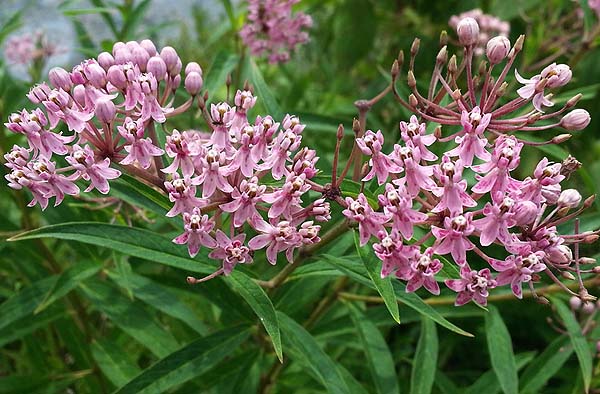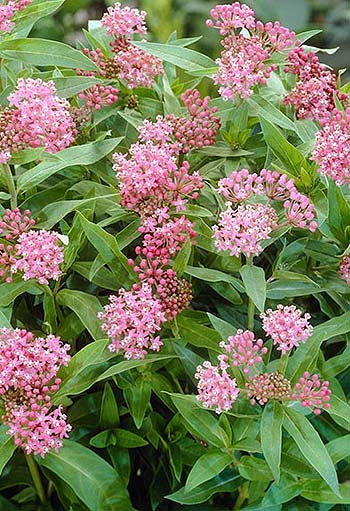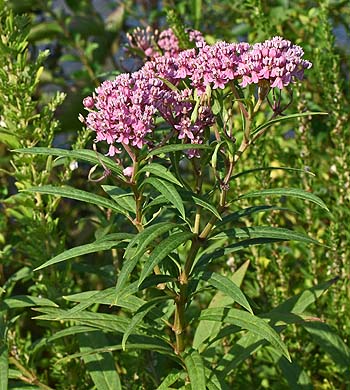Help save the Monarch butterflies by growing this beautiful plant. This very hardy (zone 3-8) native American perennial grows in compact clumps and behaves well in the garden. It loves full sun and is one plant that really likes heavy clay soil. It prefers wet to moist areas but will grow in other soils if given regular water. The flowers are stunning and it flowers for over a month during which it is a magnet for almost any butterfly or hummingbird in the area as well as a large range of other pollinators. Its very easy to maintain and takes almost no care once established.
If you care about pollinators, like butterflies and want to help the planet this plant is for you. The only downside is that it's a little bit more fiddly to get to germinate, but its not too much of a problem. Deer and rabbits don't eat and its perfect for swamps and rain gardens. No garden should be without it if you want guaranteed color in your garden every year.
If you prefer a milkweed that does not need as much water we also offer Common Milkweed (Asclepias syriaca) a more stand alone milkweed with large ball like pink flowers and Showy Milkweed (Asclepias speciosa) even bigger flowers but does not do as well in moist south eastern states.
Description of Swamp Milkweed (Asclepias Incarnata).
A tough American native perennial hardy to zone 3. It dies down in the winter but in spring it begins to send up thick erect stems with narrow lanceolate leaves arranged in opposite pairs along the stem. Leaves are from 2 3/4 - 6 in (7-15 ¼ cm) long and 1/2 - 1 in (1- 2 ½ cm) wide mid green in color and coarse in texture with smooth edges. Stems for a dense clump and can reach 2-6 ft (61 - 183 cm) in height but most commonly are around 2-4 ft (61- 122 cm). Stems are generally not branched until reaching the top quarter when they begin to branch to form flower clusters. Each cluster or umbel consists of dozens of small individual flowers that have 5 downward curving oval petals surrounding five smaller upward facing ones that form a hood around the stigma and stamens. Flowers are range in color from light pink to light purple most commonly a deep rich pink and exude a pleasant fragrance that many state resembles cinnamon. Flowers bloom in late summer and last about a month. The seedpods are 3-4 in (7.6 - 10 cm) long and narrowly lanceoloid-ellipsoid in shape and are light green to begin and turn brown when mature. Seeds have large tufts of fluffy silken 'parachutes' that allow them to easily disperse the lightest breeze. This plant creates a rhizomatous root system making it tough to dig up and move. This allows the plant to create colonies when growing conditions are good. The whole plant exudes a sticky juice but in this species it is a lot less milky than most milkweeds. The flowers are loved by all kinds of butterflies, humming birds and bees.
Growing Swamp Milkweed (Asclepias Incarnata) from Seed.
While swamp milkweed is fairly easy to grow it does need some special attention first. The seed needs to be moist stratified. Most sources also state that keeping the seed cold stratified before this helps greatly with germination, which is what we have also found. To that end we keep all our seeds very cold before they are shipped to you. However to get good results you still need to moist stratify them before they will give good germination rates. There are several different methods to do this. You can either plant them directly outside in late fall or early winter and let nature do the work or you can artificially create it yourself. This is not difficult but does take a little patience. See our
Stratification instructions for full details on the methods for doing this.
Seeding inside.
Follow the
Stratification instructions after choosing which method you want to use. We recommend that if possible you use small pots or individual cell trays to sow seeds. This way you can transplant seedlings as they grow without disturbing any seeds that have yet to germinate. Milkweeds need at least 30 days of cold stratification to germinate but much longer is great. If you want to seed your trays in winter and put them in a cold shed or garage until spring they will be fine. All milkweeds tend to create large tap roots and they don't like to be disturbed so growing in individual pots or even peat pots is recommended.
Once seeds have been removed from their cold treatment keep them in a cool environment to germinate. Do not put on heat pads or in a very warm place. Swamp milkweed will not germinate if the soil temperatures are over 85°F ( 29 °C).
Indoor sowing allows you to have much more control over your seedlings and where they are germinating before transplanting outside. Its also a lot easier to control weeds.
Direct sowing outside.
This can be done in late fall to early winter. Decide where you want the plants to grow and clear the area remove as many weeds and small roots that might be weeds as you can. Plant the seeds individually or in pairs spaced about 2-3 feet (61-91 cm) apart. Seeds can always be thinned after they have germinated. Lightly cover the seeds with soil and water in well. Ensure that the area does not dry out over the winter. If the weather is mild and dry add some water to the soil to keep it moist. The objective is to have the seeds get cold and even freeze of a period that will break the dormancy.
When spring comes keep checking the area and remove any obvious weeds. Don't pull anything you don't know what it is just in case). Keep as weed free as possible while seeds germinate and grow. Thin seedlings as necessary. You may want to try transplanting the seedlings but take care they don't like their roots disturbed that much.
Transplanting.
Harden seedlings off outside and slowly introduce them to full sunshine before planting out. Grow in small pots so that the roots will almost fill the pot before transplanting when the plant is about 3" (7.6 cm) tall as this will reduce the shock to the roots. Seedlings should be in individual pots. Don't water the plants for a day or more before transplanting to ensure that the soil remains together. Try to remove the whole of the soil mass and place in the transplant hole without disturbing the roots. Water well and keep moist. Even so the plants may take some time to recover from the transplant shock and may even loose some or all of their leaves. Don't despair most usually recover but occasionally there are some that don't.
Location and Care of Swamp Milkweed (Asclepias Incarnata).
This plant likes sunshine, it will tolerate some shade but not a great deal. It also likes moisture and is ideal for those wet boggy areas and never quite dry out. Its also a great plant for rain gardens although it may need some extra water during droughts. While it prefers wet conditions it will also do well in other areas provided supplementary water is supplied. So it can be grown in most gardens.
If your soils are much dryer then grow either
Common Milkweed or
Showy Milkweed instead.
Soil type. This is one plant that loves clay soil and will do very well there. It will do well in most soils that hold water in some manner and is least happy on sandy well drained soils. If your soil is one of these don't despair you can still grow this plant with just a little more effort in bed preparation.
Bed preparation for more well drained soils.
Pick the site you want it should be in full sun and in an area where you can easily water it. Remove all the weeds and clear the soil then add at least 8" of heavy compost dig this into the soil and tamp down before planting your seedlings. If your soil is very sandy you many consider placing a semi permeable barrier like weed block or ground fabric at the bottom of the bed. For this you will need to dig out the soil to a depth of about 2 feet (61 cm). Lay the fabric in the trench or hole then replace the soil that has been very heavily amended with compost and good organic material.
Watering. For plants in areas that are not swampy some added water will be necessary especially in times of little rainfall. The best way to do this is to use a soaker hose. Snake the hose in around each of the plant roots then it can be connected to the water line when needed or even put on a timer so that the water comes on at the same time every day or so.
For plants in rain gardens watering will only be necessarily when there has been no rain and the rain garden has dried out.
Maintenance.
Milkweeds really don't need much care at all once established. Because of its clumping nature this plant is very well behaved in the garden and while the clumps will grow in size it does not spread rapidly. Cutting the dead material down either in late fall or early spring helps keep the plants tidy and neat. Apart from that and watering, depending on soil, they should need little care at all. Plants in wet areas may start to spread out more so they may need to be divided or controlled if you don't want them in the whole area, but mostly its best to choose and area and let them have full rein. It will look magnificent when they flower.
Culinary Uses of Swamp Milkweed (Asclepias Incarnata).
Although milkweeds are poisonous raw, the young shoots, leaves and seed pods are all edible cooked. However many consider this as famine food. You can if you have to but its nothing to get excited about. If deciding to cook them they should be placed in cold water and brought to a boil and simmered till tender, milkweeds are said to be delicately flavored and harmless. The flower buds, nectar-sweet flowers and seeds are also edible.
Medical uses of Swamp Milkweed (Asclepias Incarnata).
Use Medicinal: In the past, the roots of swamp milkweed were simmered to make a tea taken in small quantities both as a general purge and to destroy and expel parasitic worms.
Warning: This plant is considered toxic but only in large quantities since the sap is much weaker than with other milkweeds. However some people find the that sap irritates their skin and can cause and itchy rash. Eating the mature plant can cause vomiting, stupor, weakness, spasms. This is more likely in young children as the mature plant is in no way desirable to eat.
Major use.
Swamp milkweeds like other milkweeds are the major food for caterpillars of Monarch butterflies which are badly in danger due to the huge reduction in milkweed populations across the United States. However the flowers are also attractive to all kinds of other butterflies as well as hummingbirds and hummingbird moths, bees and all kinds of other pollinators. Its basically a pollinator magnet. Grow this and you will be helping a lot of pollinators survive while you enjoy their beauty.








